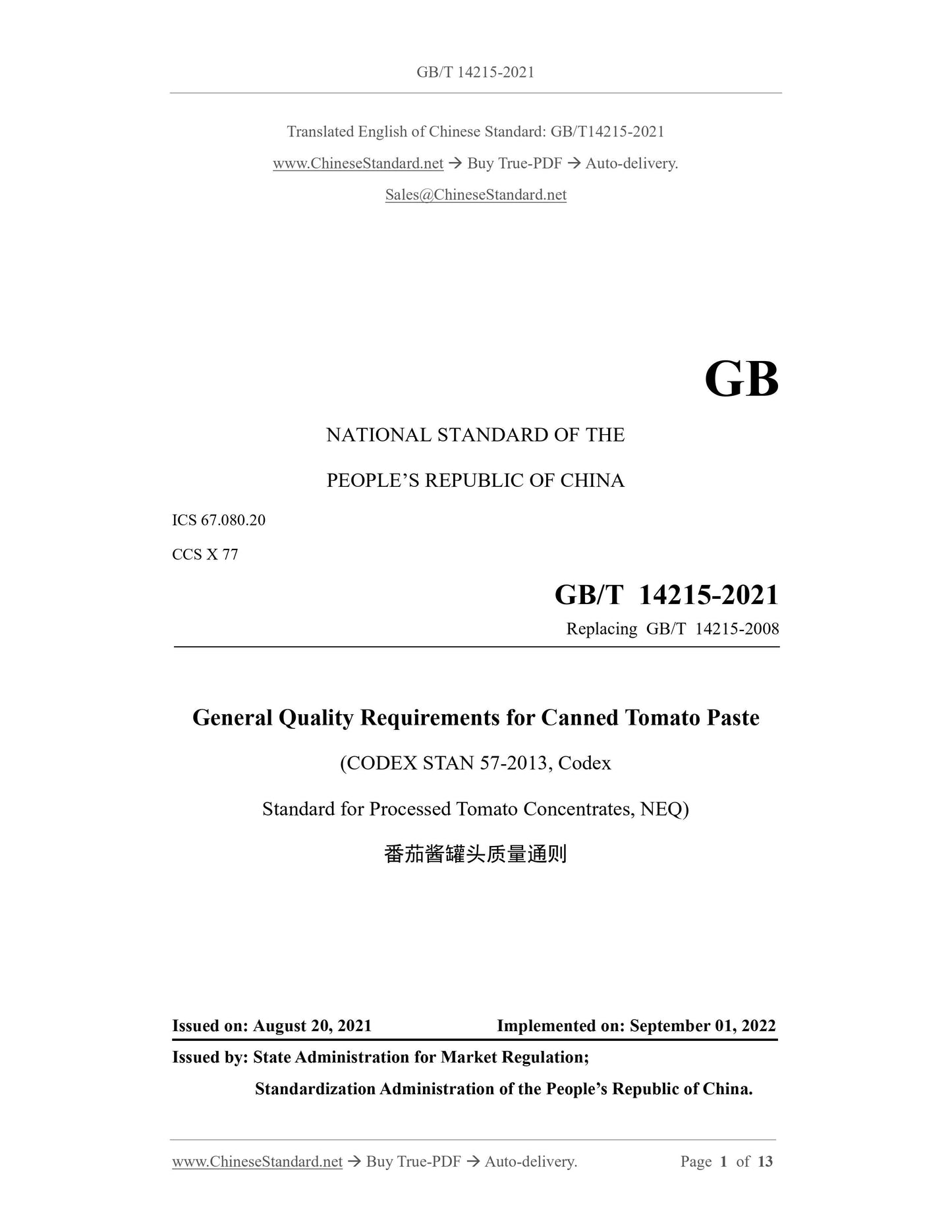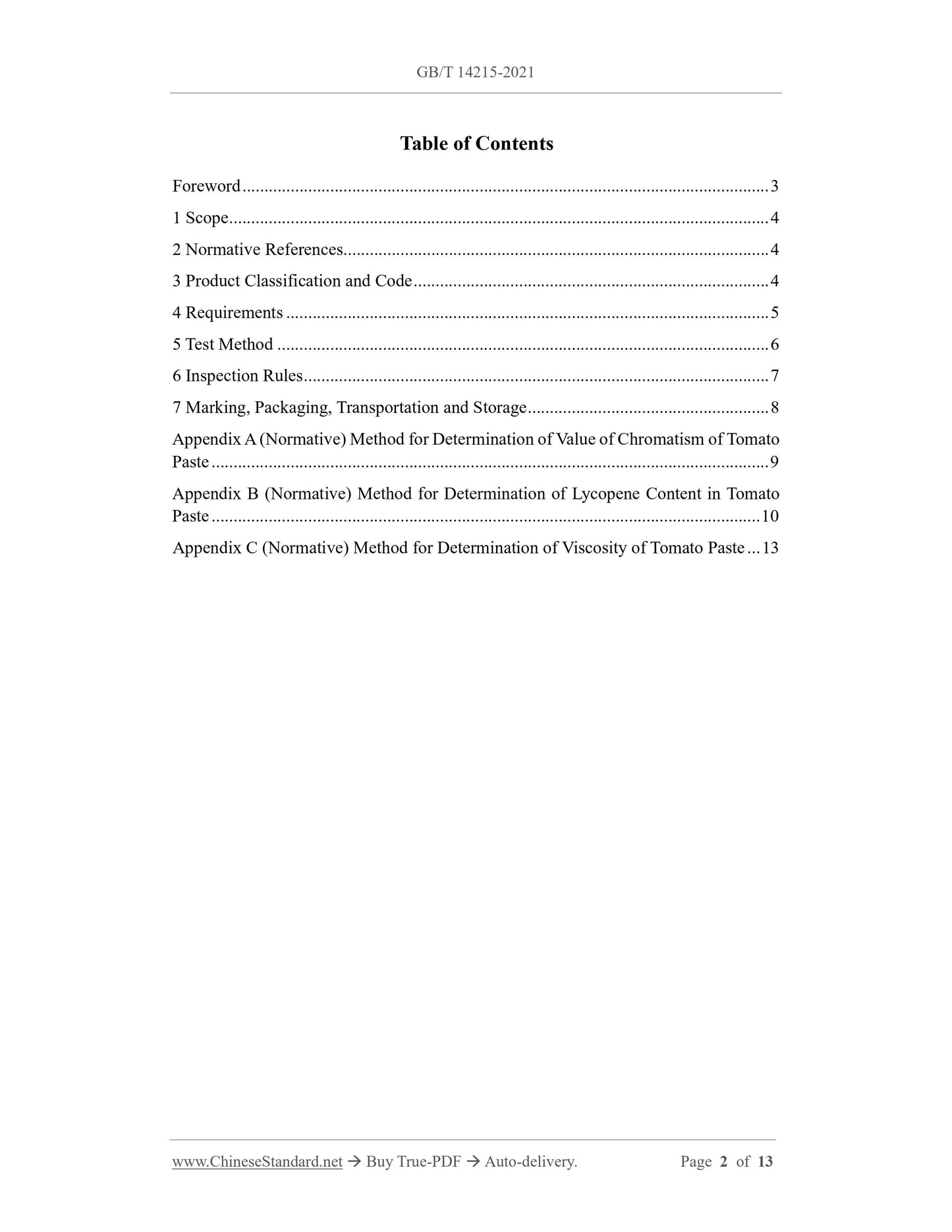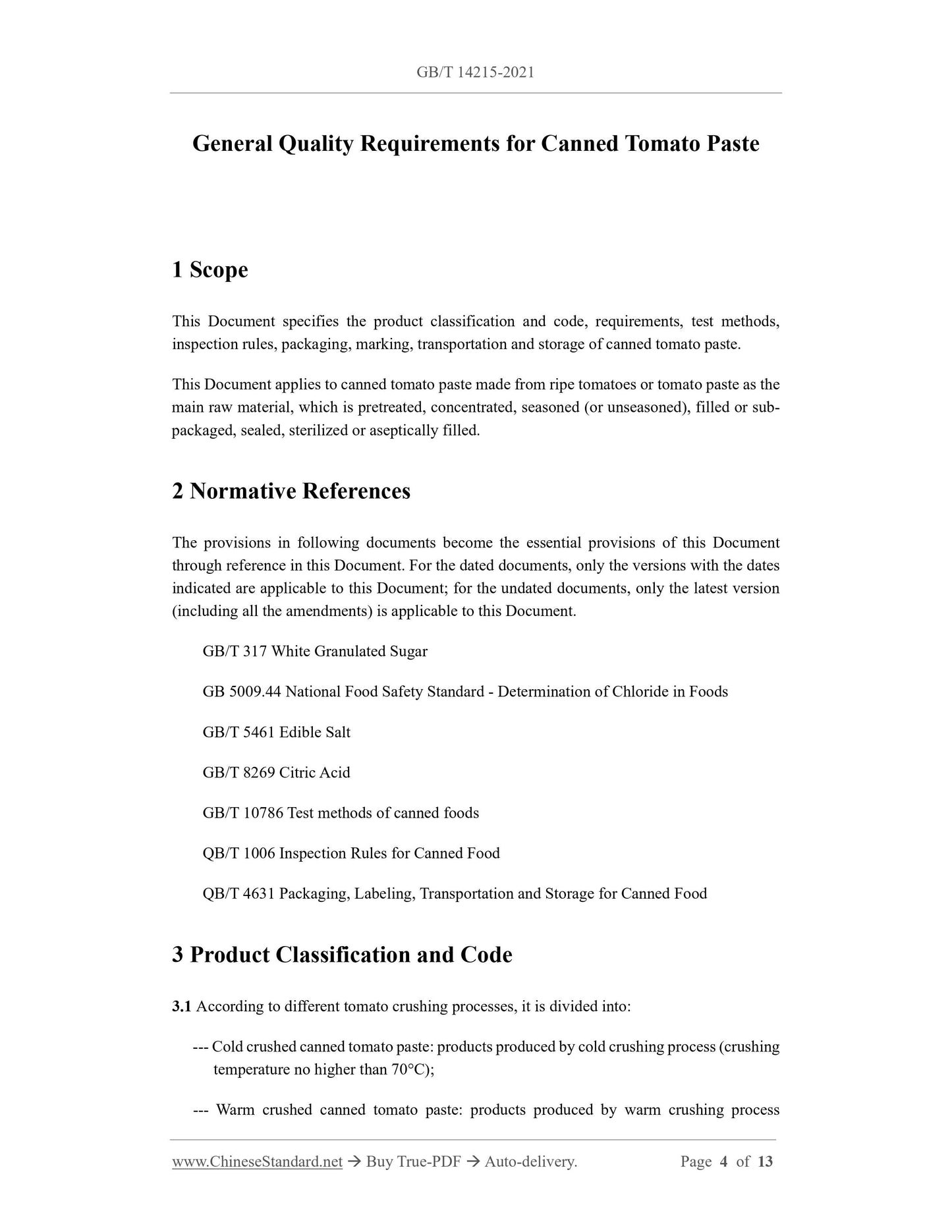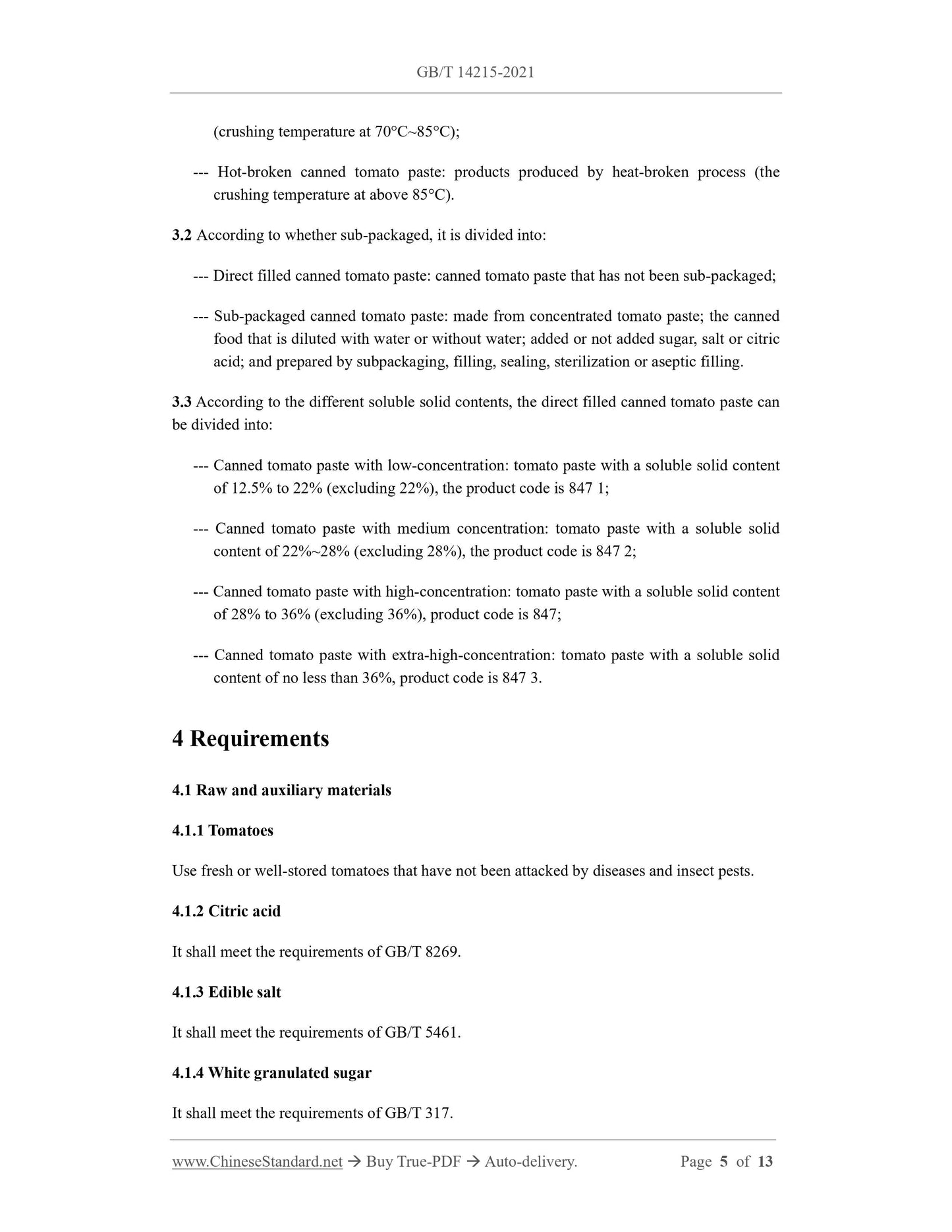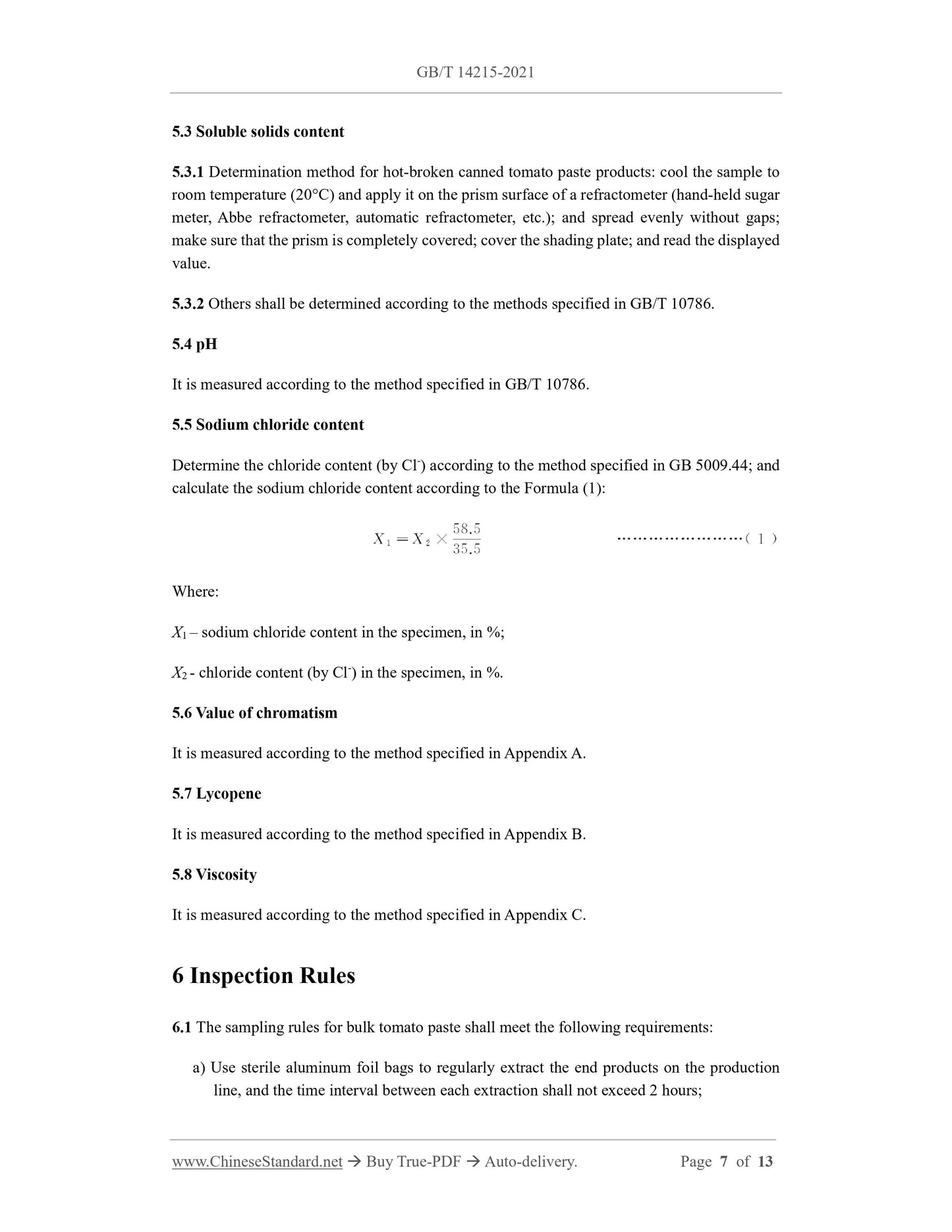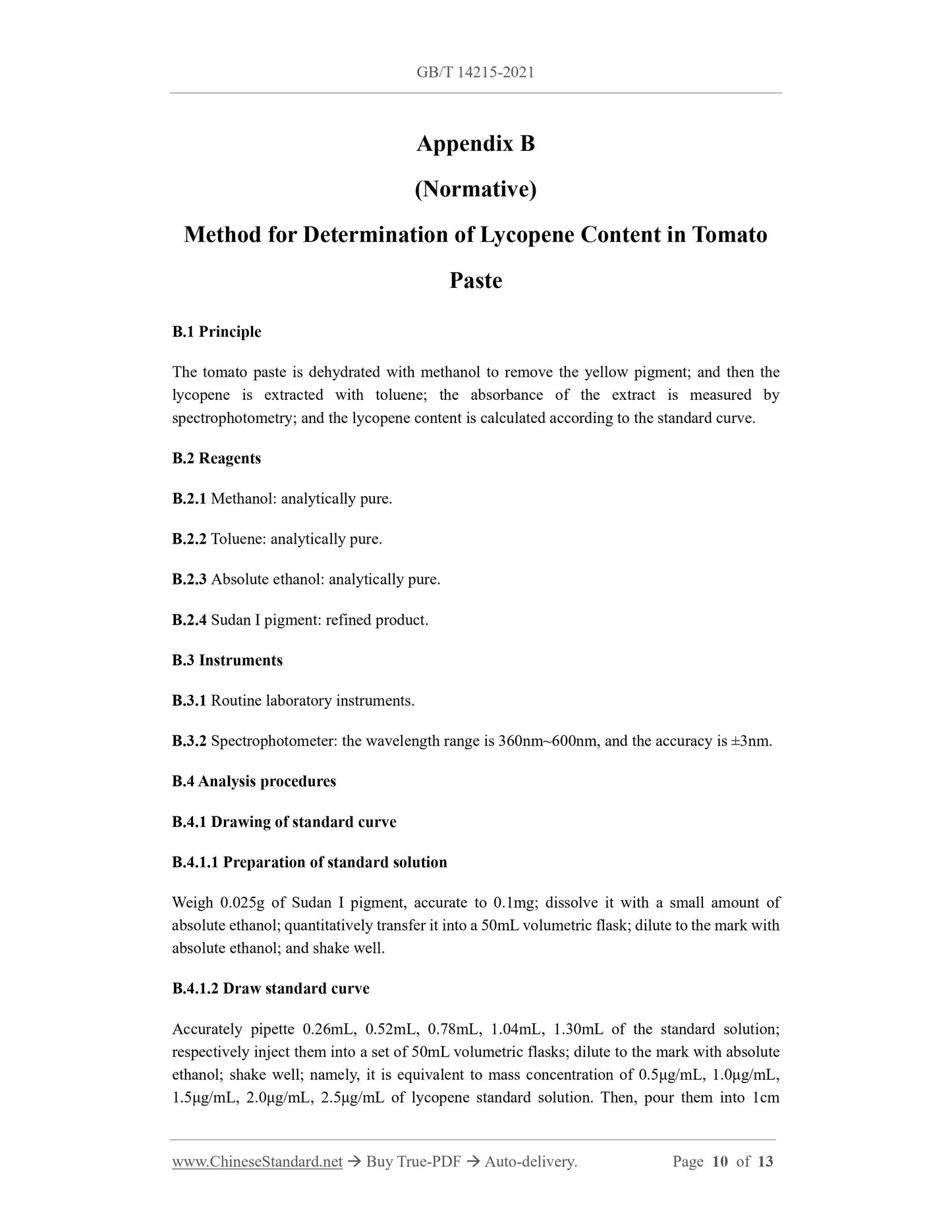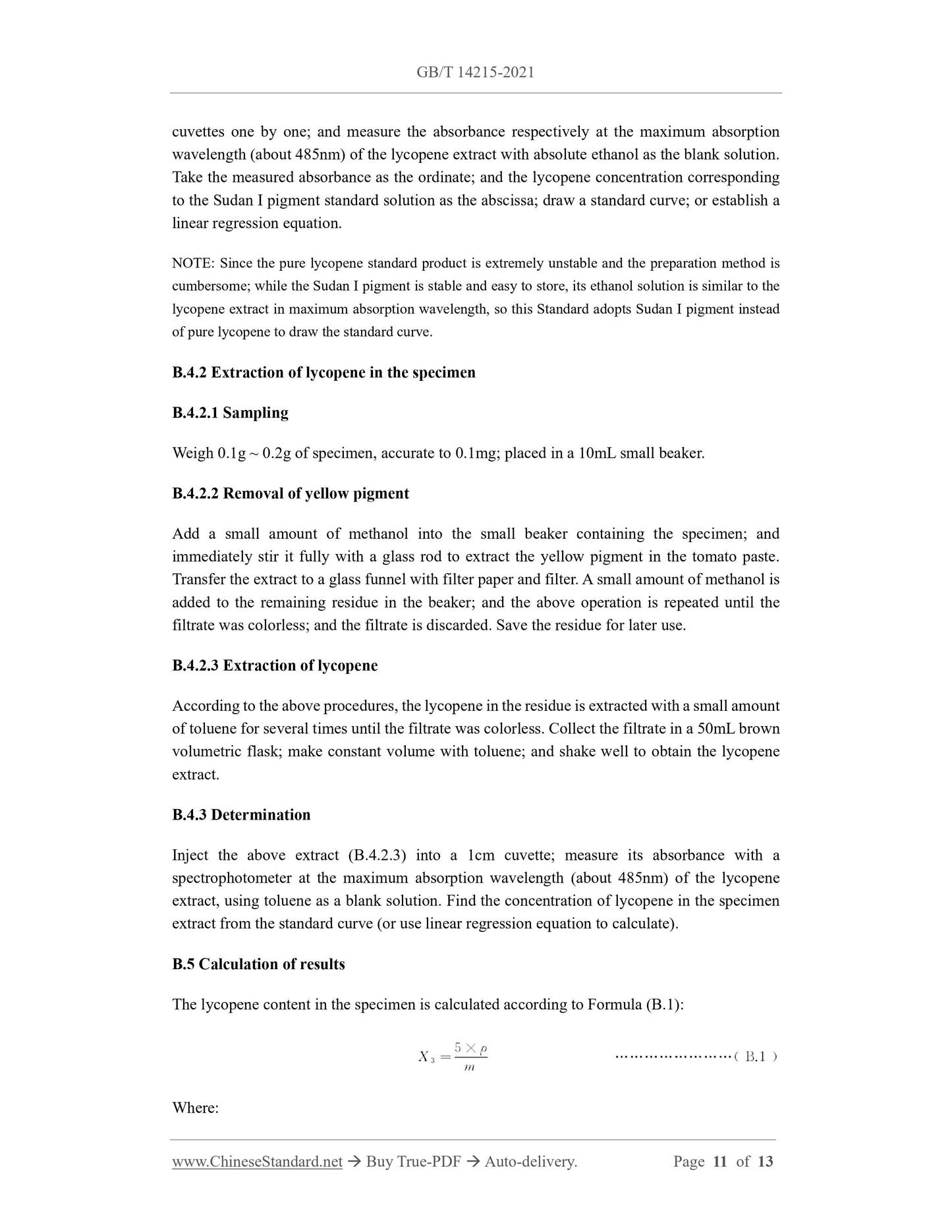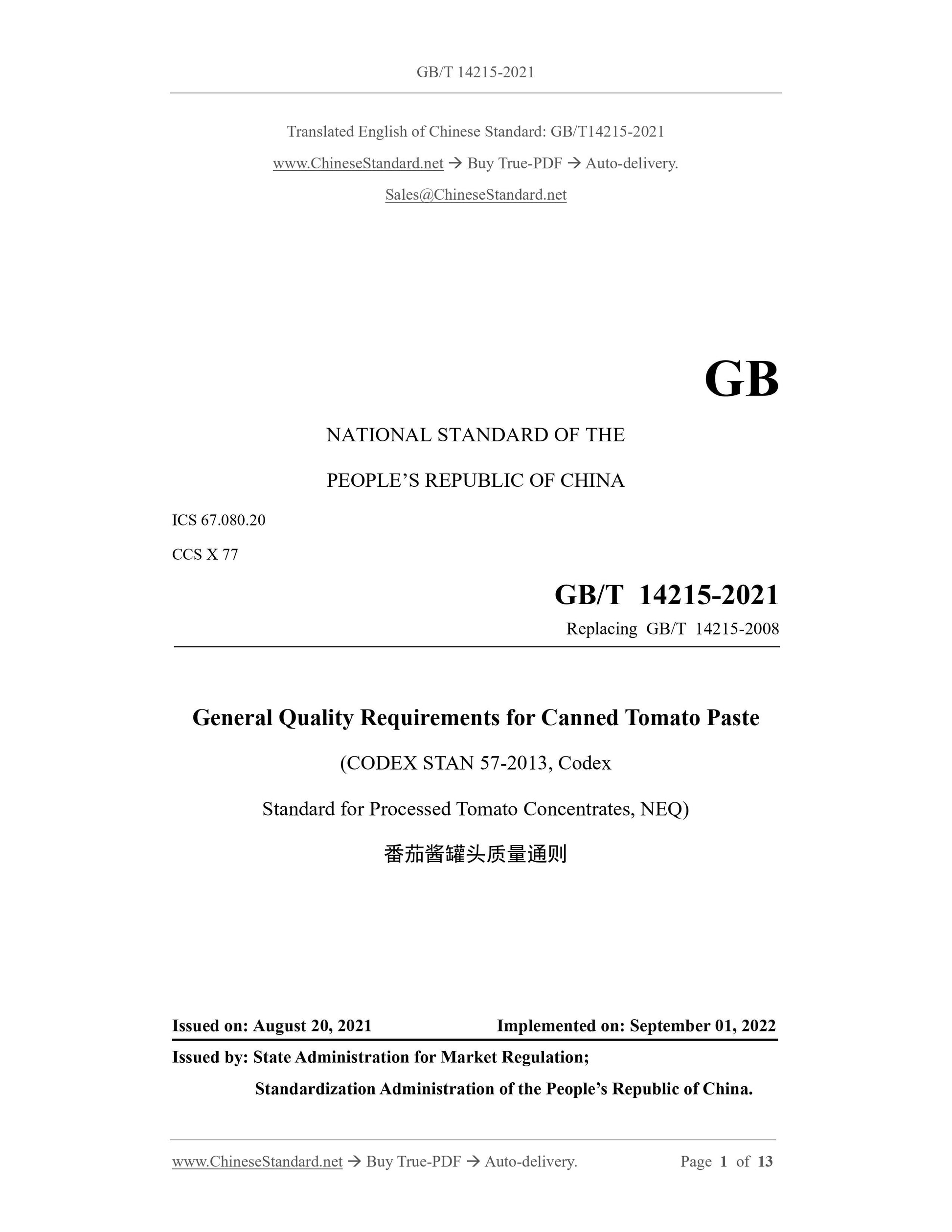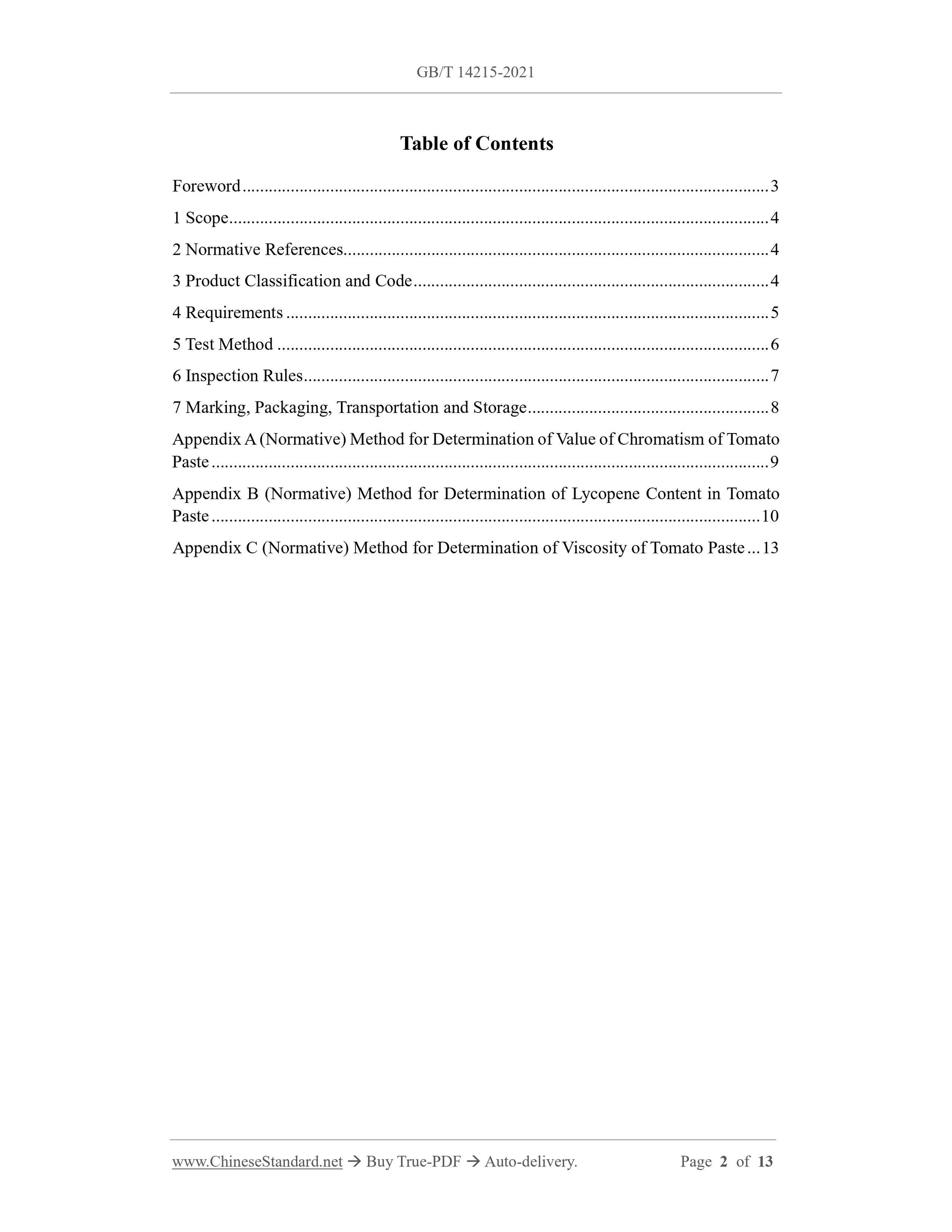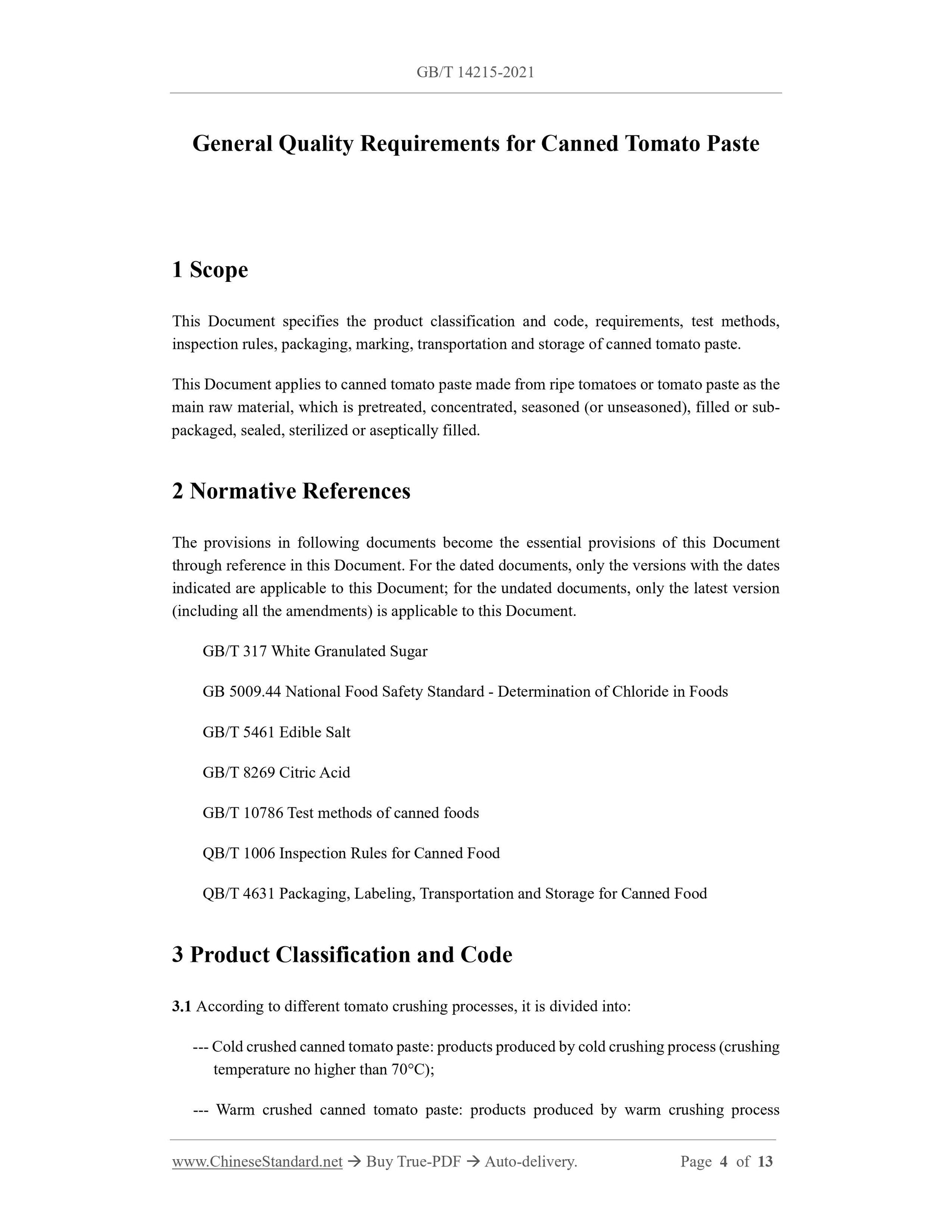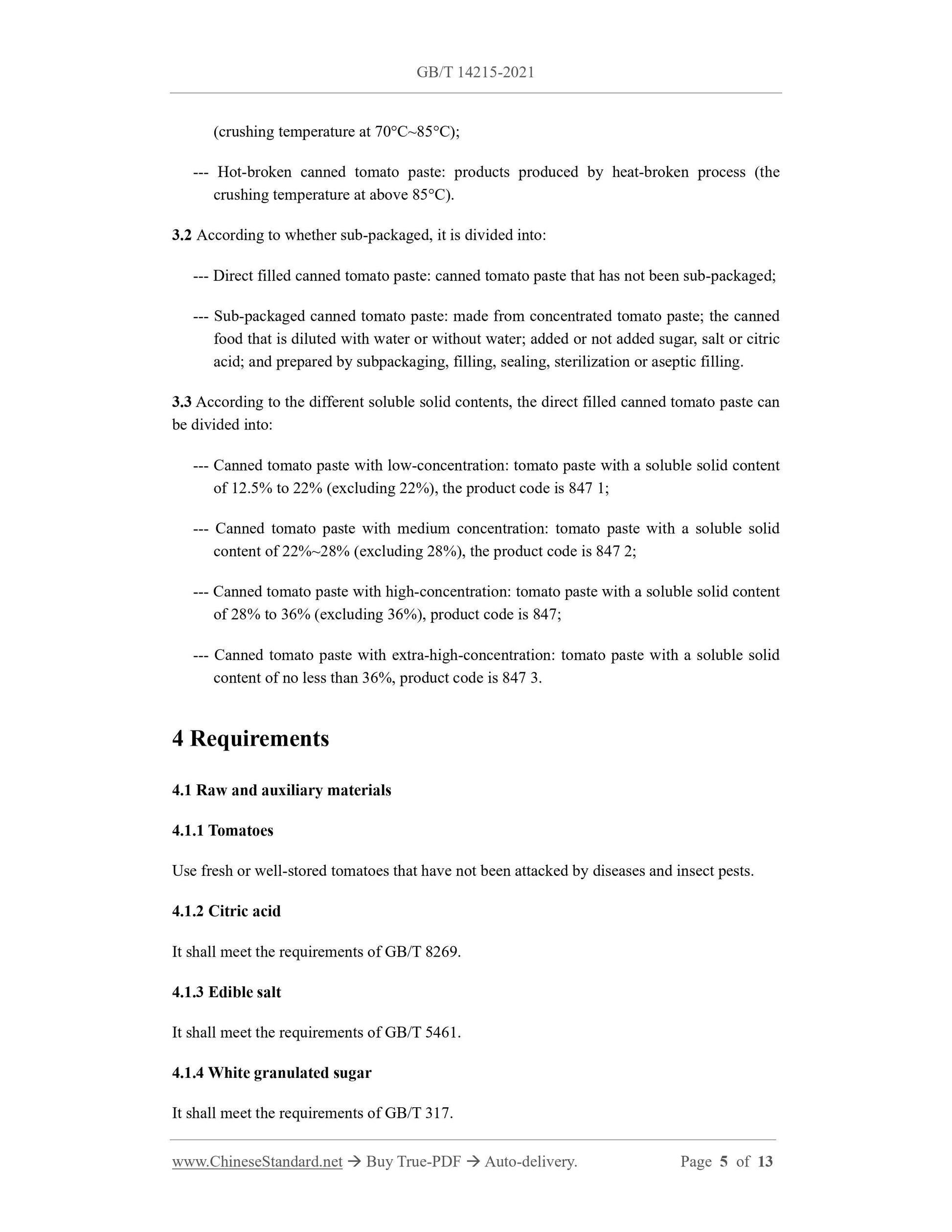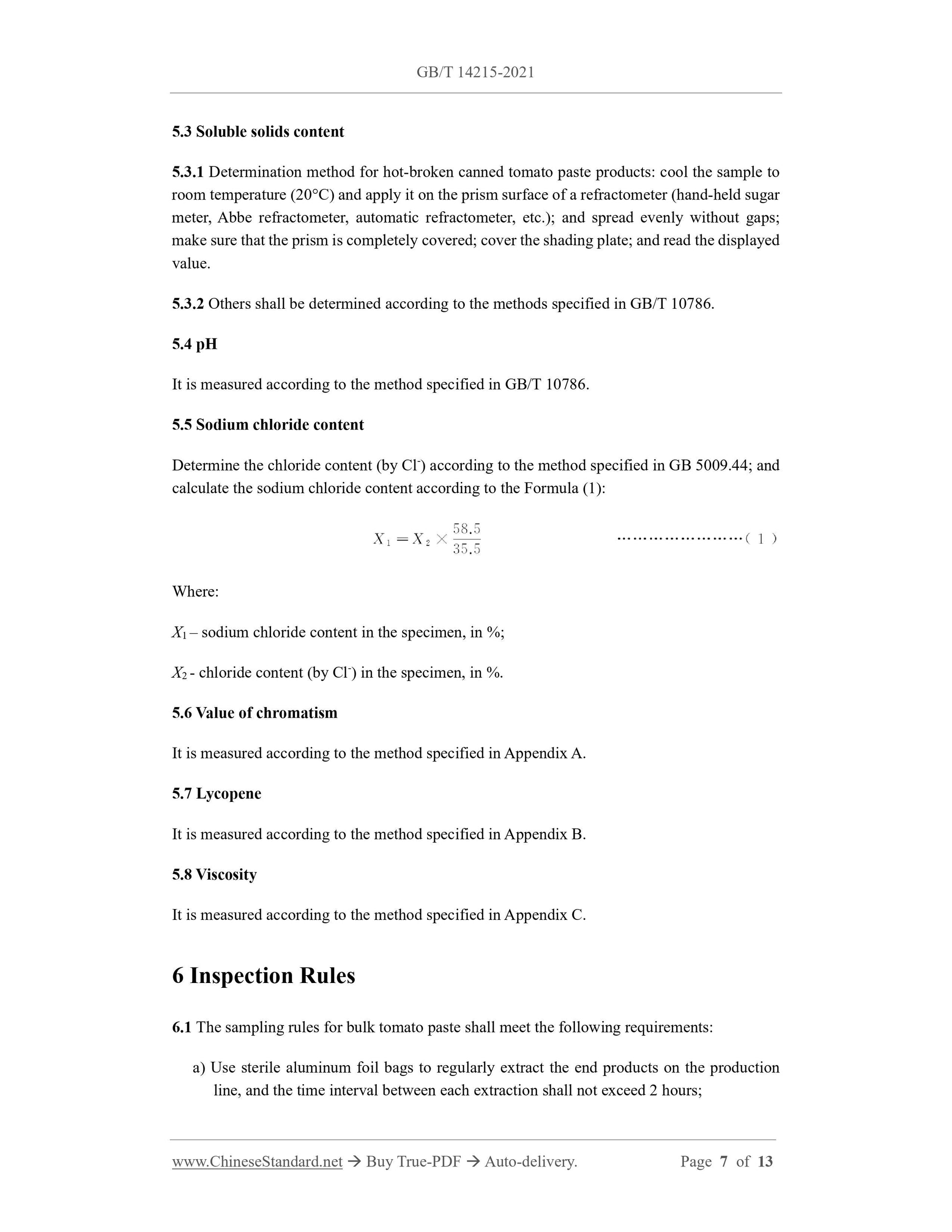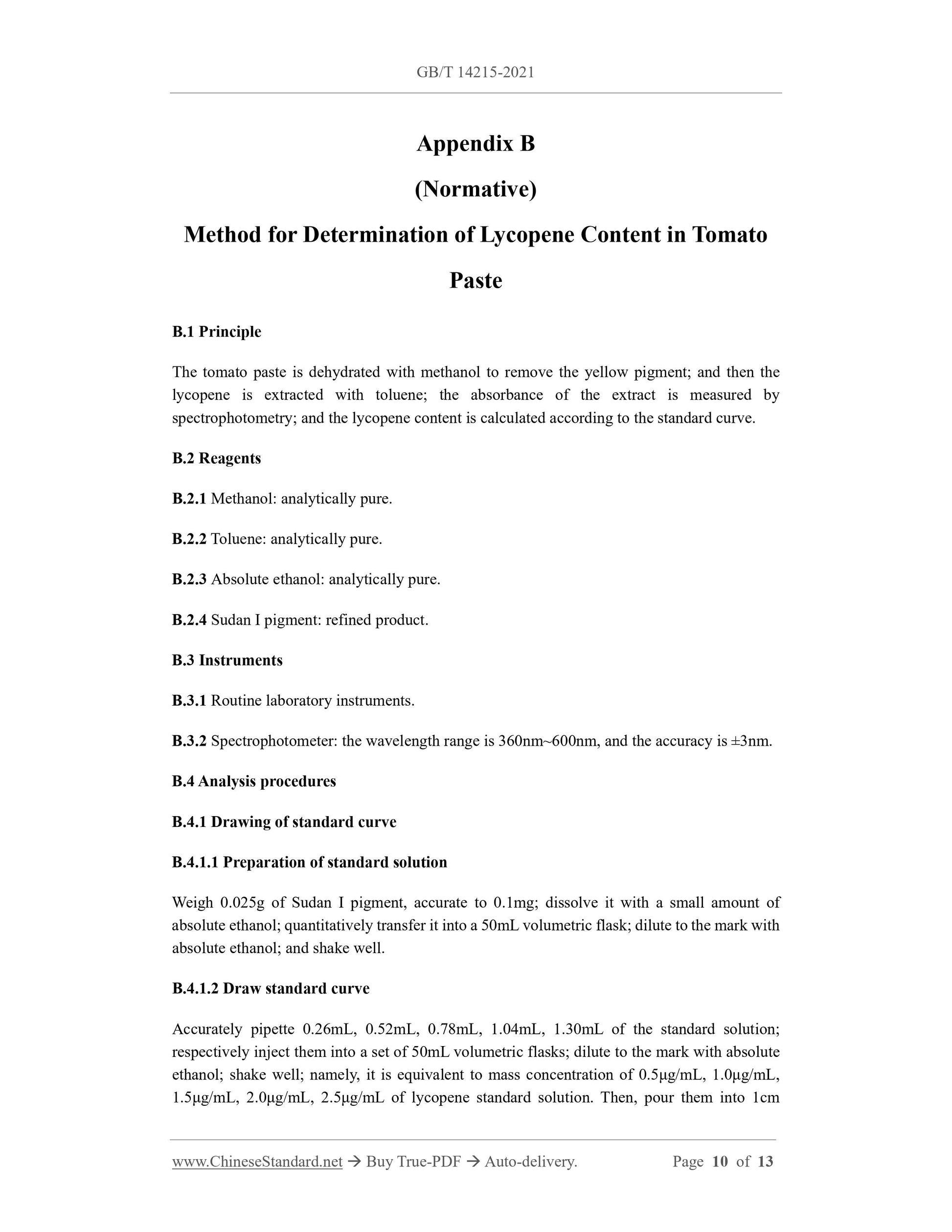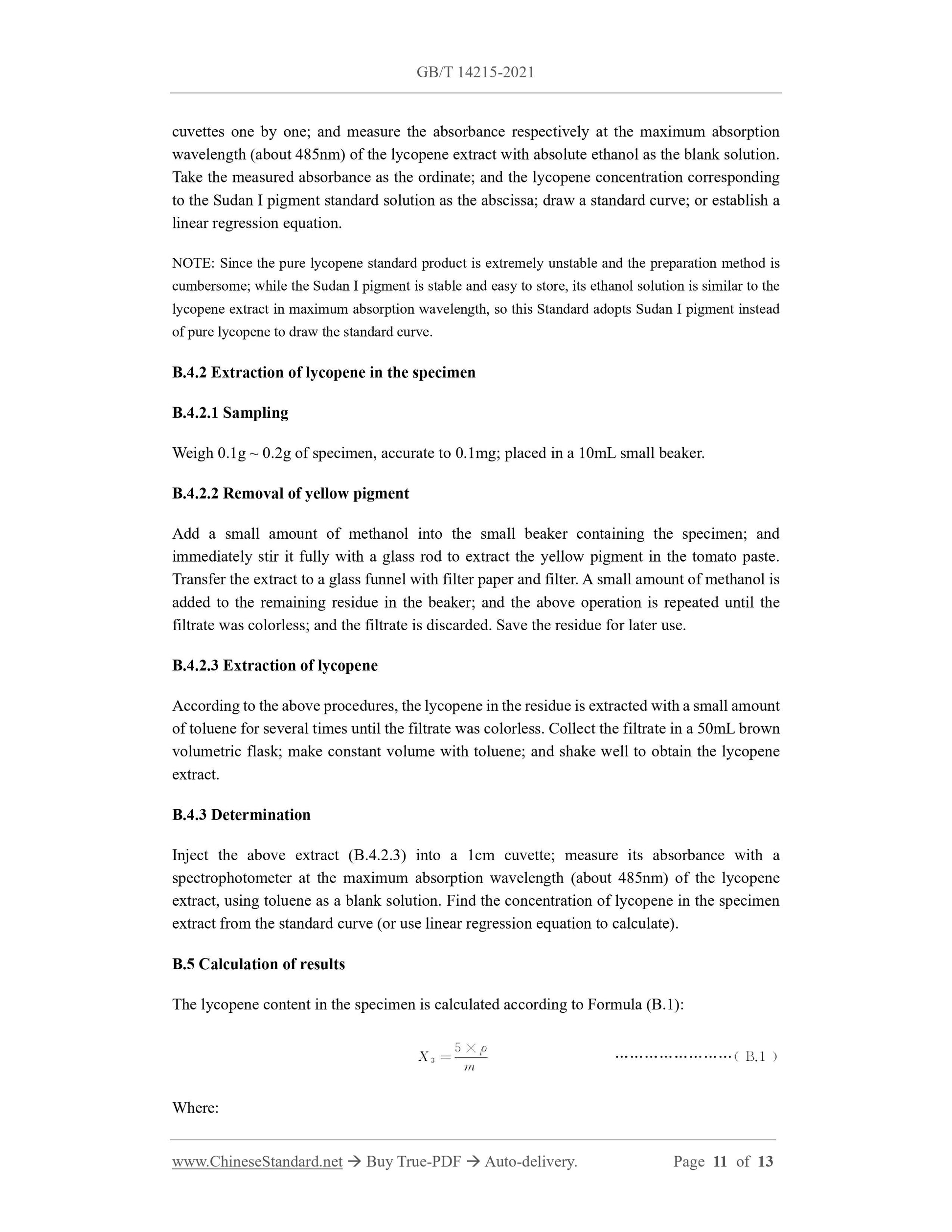PayPal, credit cards. Download editable-PDF and invoice in 1 second!
GB/T 14215-2021 English PDF (GBT14215-2021)
GB/T 14215-2021 English PDF (GBT14215-2021)
Precio habitual
$170.00 USD
Precio habitual
Precio de oferta
$170.00 USD
Precio unitario
/
por
Los gastos de envío se calculan en la pantalla de pago.
No se pudo cargar la disponibilidad de retiro
Delivery: 3 seconds. Download true-PDF + Invoice.
Get QUOTATION in 1-minute: Click GB/T 14215-2021
Historical versions: GB/T 14215-2021
Preview True-PDF (Reload/Scroll if blank)
GB/T 14215-2021: General quality requirements for canned tomato paste
GB/T 14215-2021
GB
NATIONAL STANDARD OF THE
PEOPLE’S REPUBLIC OF CHINA
ICS 67.080.20
CCS X 77
Replacing GB/T 14215-2008
General Quality Requirements for Canned Tomato Paste
(CODEX STAN 57-2013, Codex
Standard for Processed Tomato Concentrates, NEQ)
ISSUED ON: AUGUST 20, 2021
IMPLEMENTED ON: SEPTEMBER 01, 2022
Issued by: State Administration for Market Regulation;
Standardization Administration of the People’s Republic of China.
Table of Contents
Foreword ... 3
1 Scope ... 4
2 Normative References ... 4
3 Product Classification and Code ... 4
4 Requirements ... 5
5 Test Method ... 6
6 Inspection Rules ... 7
7 Marking, Packaging, Transportation and Storage ... 8
Appendix A (Normative) Method for Determination of Value of Chromatism of Tomato
Paste ... 9
Appendix B (Normative) Method for Determination of Lycopene Content in Tomato
Paste ... 10
Appendix C (Normative) Method for Determination of Viscosity of Tomato Paste ... 13
General Quality Requirements for Canned Tomato Paste
1 Scope
This Document specifies the product classification and code, requirements, test methods,
inspection rules, packaging, marking, transportation and storage of canned tomato paste.
This Document applies to canned tomato paste made from ripe tomatoes or tomato paste as the
main raw material, which is pretreated, concentrated, seasoned (or unseasoned), filled or sub-
packaged, sealed, sterilized or aseptically filled.
2 Normative References
The provisions in following documents become the essential provisions of this Document
through reference in this Document. For the dated documents, only the versions with the dates
indicated are applicable to this Document; for the undated documents, only the latest version
(including all the amendments) is applicable to this Document.
GB/T 317 White Granulated Sugar
GB 5009.44 National Food Safety Standard - Determination of Chloride in Foods
GB/T 5461 Edible Salt
GB/T 8269 Citric Acid
GB/T 10786 Test methods of canned foods
QB/T 1006 Inspection Rules for Canned Food
QB/T 4631 Packaging, Labeling, Transportation and Storage for Canned Food
3 Product Classification and Code
3.1 According to different tomato crushing processes, it is divided into:
--- Cold crushed canned tomato paste: products produced by cold crushing process (crushing
temperature no higher than 70°C);
--- Warm crushed canned tomato paste: products produced by warm crushing process
(crushing temperature at 70°C~85°C);
--- Hot-broken canned tomato paste: products produced by heat-broken process (the
crushing temperature at above 85°C).
3.2 According to whether sub-packaged, it is divided into:
--- Direct filled canned tomato paste: canned tomato paste that has not been sub-packaged;
--- Sub-packaged canned tomato paste: made from concentrated tomato paste; the canned
food that is diluted with water or without water; added or not added sugar, salt or citric
acid; and prepared by subpackaging, filling, sealing, sterilization or aseptic filling.
3.3 According to the different soluble solid contents, the direct filled canned tomato paste can
be divided into:
--- Canned tomato paste with low-concentration: tomato paste with a soluble solid content
of 12.5% to 22% (excluding 22%), the product code is 847 1;
--- Canned tomato paste with medium concentration: tomato paste with a soluble solid
content of 22%~28% (excluding 28%), the product code is 847 2;
--- Canned tomato paste with high-concentration: tomato paste with a soluble solid content
of 28% to 36% (excluding 36%), product code is 847;
--- Canned tomato paste with extra-high-concentration: tomato paste with a soluble solid
content of no less than 36%, product code is 847 3.
4 Requirements
4.1 Raw and auxiliary materials
4.1.1 Tomatoes
Use fresh or well-stored tomatoes that have not been attacked by diseases and insect pests.
4.1.2 Citric acid
It shall meet the requirements of GB/T 8269.
4.1.3 Edible salt
It shall meet the requirements of GB/T 5461.
4.1.4 White granulated sugar
It shall meet the requirements of GB/T 317.
5.3 Soluble solids content
5.3.1 Determination method for hot-broken canned tomato paste products: cool the sample to
room temperature (20°C) and apply it on the prism surface of a refractometer (hand-held sugar
meter, Abbe refractometer, automatic refractometer, etc.); and spread evenly without gaps;
make sure that the prism is completely covered; cover the shading plate; and read the displayed
value.
5.3.2 Others shall be determined according to the methods specified in GB/T 10786.
5.4 pH
It is measured according to the method specified in GB/T 10786.
5.5 Sodium chloride content
Determine the chloride content (by Cl-) according to the method specified in GB 5009.44; and
calculate the sodium chloride content according to the Formula (1):
Where:
X1 – sodium chloride content in the specimen, in %;
X2 - chloride content (by Cl-) in the specimen, in %.
5.6 Value of chromatism
It is measured according to the method specified in Appendix A.
5.7 Lycopene
It is measured according to the method specified in Appendix B.
5.8 Viscosity
It is measured according to the method specified in Appendix C.
6 Inspection Rules
6.1 The sampling rules for bulk tomato paste shall meet the following requirements:
a) Use sterile aluminum foil bags to regularly extract the end products on the production
line, and the time interval between each extraction shall not exceed 2 hours;
Appendix B
(Normative)
Method for Determination of Lycopene Content in Tomato
Paste
B.1 Principle
The tomato paste is dehydrated with methanol to remove the yellow pigment; and then the
lycopene is extracted with toluene; the absorbance of the extract is measured by
spectrophotometry; and the lycopene content is calculated according to the standard curve.
B.2 Reagents
B.2.1 Methanol: analytically pure.
B.2.2 Toluene: analytically pure.
B.2.3 Absolute ethanol: analytically pure.
B.2.4 Sudan I pigment: refined product.
B.3 Instruments
B.3.1 Routine laboratory instruments.
B.3.2 Spectrophotometer: the wavelength range is 360nm~600nm, and the accuracy is ±3nm.
B.4 Analysis procedures
B.4.1 Drawing of standard curve
B.4.1.1 Preparation of standard solution
Weigh 0.025g of Sudan I pigment, accurate to 0.1mg; dissolve it with a small amount of
absolute ethanol; quantitatively transfer it into a 50mL volumetric flask; dilute to the mark with
absolute ethanol; and shake well.
B.4.1.2 Draw standard curve
Accurately pipette 0.26mL, 0.52mL, 0.78mL, 1.04mL, 1.30mL of the standard solution;
respectively inject them into a set of 50mL volumetric flasks; dilute to the mark with absolute
ethanol; shake well; namely, it is equivalent to mass concentration of 0.5μg/mL, 1.0μg/mL,
1.5μg/mL, 2.0μg/mL, 2.5μg/mL of lycopene standard solution. Then, pour them into 1cm
cuvettes one by one; and measure the absorbance respectively at the maximum absorption
wavelength (about 485nm) of the lycopene extract with absolute ethanol as the blank solution.
Take the measured absorbance as the ordinate; and the lycopene concentration corresponding
to the Sudan Ⅰ pigment standard solution as the abscissa; draw a standard curve; or establish a
linear regression equation.
NOTE: Since the pure lycopene standard product is extremely unstable and the preparation method is
cumbersome; while the Sudan Ⅰ pigment is stable and ...
Get QUOTATION in 1-minute: Click GB/T 14215-2021
Historical versions: GB/T 14215-2021
Preview True-PDF (Reload/Scroll if blank)
GB/T 14215-2021: General quality requirements for canned tomato paste
GB/T 14215-2021
GB
NATIONAL STANDARD OF THE
PEOPLE’S REPUBLIC OF CHINA
ICS 67.080.20
CCS X 77
Replacing GB/T 14215-2008
General Quality Requirements for Canned Tomato Paste
(CODEX STAN 57-2013, Codex
Standard for Processed Tomato Concentrates, NEQ)
ISSUED ON: AUGUST 20, 2021
IMPLEMENTED ON: SEPTEMBER 01, 2022
Issued by: State Administration for Market Regulation;
Standardization Administration of the People’s Republic of China.
Table of Contents
Foreword ... 3
1 Scope ... 4
2 Normative References ... 4
3 Product Classification and Code ... 4
4 Requirements ... 5
5 Test Method ... 6
6 Inspection Rules ... 7
7 Marking, Packaging, Transportation and Storage ... 8
Appendix A (Normative) Method for Determination of Value of Chromatism of Tomato
Paste ... 9
Appendix B (Normative) Method for Determination of Lycopene Content in Tomato
Paste ... 10
Appendix C (Normative) Method for Determination of Viscosity of Tomato Paste ... 13
General Quality Requirements for Canned Tomato Paste
1 Scope
This Document specifies the product classification and code, requirements, test methods,
inspection rules, packaging, marking, transportation and storage of canned tomato paste.
This Document applies to canned tomato paste made from ripe tomatoes or tomato paste as the
main raw material, which is pretreated, concentrated, seasoned (or unseasoned), filled or sub-
packaged, sealed, sterilized or aseptically filled.
2 Normative References
The provisions in following documents become the essential provisions of this Document
through reference in this Document. For the dated documents, only the versions with the dates
indicated are applicable to this Document; for the undated documents, only the latest version
(including all the amendments) is applicable to this Document.
GB/T 317 White Granulated Sugar
GB 5009.44 National Food Safety Standard - Determination of Chloride in Foods
GB/T 5461 Edible Salt
GB/T 8269 Citric Acid
GB/T 10786 Test methods of canned foods
QB/T 1006 Inspection Rules for Canned Food
QB/T 4631 Packaging, Labeling, Transportation and Storage for Canned Food
3 Product Classification and Code
3.1 According to different tomato crushing processes, it is divided into:
--- Cold crushed canned tomato paste: products produced by cold crushing process (crushing
temperature no higher than 70°C);
--- Warm crushed canned tomato paste: products produced by warm crushing process
(crushing temperature at 70°C~85°C);
--- Hot-broken canned tomato paste: products produced by heat-broken process (the
crushing temperature at above 85°C).
3.2 According to whether sub-packaged, it is divided into:
--- Direct filled canned tomato paste: canned tomato paste that has not been sub-packaged;
--- Sub-packaged canned tomato paste: made from concentrated tomato paste; the canned
food that is diluted with water or without water; added or not added sugar, salt or citric
acid; and prepared by subpackaging, filling, sealing, sterilization or aseptic filling.
3.3 According to the different soluble solid contents, the direct filled canned tomato paste can
be divided into:
--- Canned tomato paste with low-concentration: tomato paste with a soluble solid content
of 12.5% to 22% (excluding 22%), the product code is 847 1;
--- Canned tomato paste with medium concentration: tomato paste with a soluble solid
content of 22%~28% (excluding 28%), the product code is 847 2;
--- Canned tomato paste with high-concentration: tomato paste with a soluble solid content
of 28% to 36% (excluding 36%), product code is 847;
--- Canned tomato paste with extra-high-concentration: tomato paste with a soluble solid
content of no less than 36%, product code is 847 3.
4 Requirements
4.1 Raw and auxiliary materials
4.1.1 Tomatoes
Use fresh or well-stored tomatoes that have not been attacked by diseases and insect pests.
4.1.2 Citric acid
It shall meet the requirements of GB/T 8269.
4.1.3 Edible salt
It shall meet the requirements of GB/T 5461.
4.1.4 White granulated sugar
It shall meet the requirements of GB/T 317.
5.3 Soluble solids content
5.3.1 Determination method for hot-broken canned tomato paste products: cool the sample to
room temperature (20°C) and apply it on the prism surface of a refractometer (hand-held sugar
meter, Abbe refractometer, automatic refractometer, etc.); and spread evenly without gaps;
make sure that the prism is completely covered; cover the shading plate; and read the displayed
value.
5.3.2 Others shall be determined according to the methods specified in GB/T 10786.
5.4 pH
It is measured according to the method specified in GB/T 10786.
5.5 Sodium chloride content
Determine the chloride content (by Cl-) according to the method specified in GB 5009.44; and
calculate the sodium chloride content according to the Formula (1):
Where:
X1 – sodium chloride content in the specimen, in %;
X2 - chloride content (by Cl-) in the specimen, in %.
5.6 Value of chromatism
It is measured according to the method specified in Appendix A.
5.7 Lycopene
It is measured according to the method specified in Appendix B.
5.8 Viscosity
It is measured according to the method specified in Appendix C.
6 Inspection Rules
6.1 The sampling rules for bulk tomato paste shall meet the following requirements:
a) Use sterile aluminum foil bags to regularly extract the end products on the production
line, and the time interval between each extraction shall not exceed 2 hours;
Appendix B
(Normative)
Method for Determination of Lycopene Content in Tomato
Paste
B.1 Principle
The tomato paste is dehydrated with methanol to remove the yellow pigment; and then the
lycopene is extracted with toluene; the absorbance of the extract is measured by
spectrophotometry; and the lycopene content is calculated according to the standard curve.
B.2 Reagents
B.2.1 Methanol: analytically pure.
B.2.2 Toluene: analytically pure.
B.2.3 Absolute ethanol: analytically pure.
B.2.4 Sudan I pigment: refined product.
B.3 Instruments
B.3.1 Routine laboratory instruments.
B.3.2 Spectrophotometer: the wavelength range is 360nm~600nm, and the accuracy is ±3nm.
B.4 Analysis procedures
B.4.1 Drawing of standard curve
B.4.1.1 Preparation of standard solution
Weigh 0.025g of Sudan I pigment, accurate to 0.1mg; dissolve it with a small amount of
absolute ethanol; quantitatively transfer it into a 50mL volumetric flask; dilute to the mark with
absolute ethanol; and shake well.
B.4.1.2 Draw standard curve
Accurately pipette 0.26mL, 0.52mL, 0.78mL, 1.04mL, 1.30mL of the standard solution;
respectively inject them into a set of 50mL volumetric flasks; dilute to the mark with absolute
ethanol; shake well; namely, it is equivalent to mass concentration of 0.5μg/mL, 1.0μg/mL,
1.5μg/mL, 2.0μg/mL, 2.5μg/mL of lycopene standard solution. Then, pour them into 1cm
cuvettes one by one; and measure the absorbance respectively at the maximum absorption
wavelength (about 485nm) of the lycopene extract with absolute ethanol as the blank solution.
Take the measured absorbance as the ordinate; and the lycopene concentration corresponding
to the Sudan Ⅰ pigment standard solution as the abscissa; draw a standard curve; or establish a
linear regression equation.
NOTE: Since the pure lycopene standard product is extremely unstable and the preparation method is
cumbersome; while the Sudan Ⅰ pigment is stable and ...
Share
